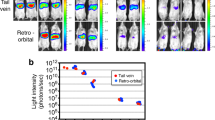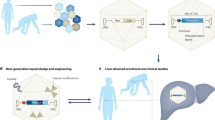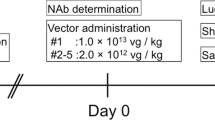Abstract
Although a variety of gene transfer methods to the liver have been designed, there are some problems such as the transfection efficiency and safety. In the present study, we developed a modified method of gene transfer into the liver by infusion of plasmid DNA via the portal vein followed by electroporation. After green fluorescence protein gene transfer, transgene expressions were detected in 24 h, and then maximally at 3 days, and persisted for 3 weeks. Histological analysis revealed that very mild tissue damage was induced in the liver to which electroporation was applied. In the second study, human hepatocyte growth factor (HGF) was more detected in the liver injected with 500 μg of human HGF gene than 100 μg of human HGF gene. However, serum HGF did not increase with 100 or 500 μg of human HGF gene. Moreover, 500 μg of HGF gene transfer into the liver by using this method could achieve the long survival of all dimethylnitrosamine-treated rats and attenuate the fibrous regions in the liver. These results suggest that HGF gene transfer into the liver via the portal vein using electroporation might be one of the useful methods for the treatment of various liver diseases.
This is a preview of subscription content, access via your institution
Access options
Subscribe to this journal
Receive 12 print issues and online access
$259.00 per year
only $21.58 per issue
Buy this article
- Purchase on Springer Link
- Instant access to full article PDF
Prices may be subject to local taxes which are calculated during checkout








Similar content being viewed by others
References
Li Q et al. Assessment of recombinant adenoviral vectors for hepatic gene therapy. Hum Gene Ther 1993; 4: 403–409.
Mulligan RC . The basic science of gene therapy. Science 1993; 243: 375–378.
Yang Y et al. Inactivation of E2a in recombinant adenoviruses improves the prospect for gene therapy in cystic fibrosis. Nat Genet 1994; 7: 362–369.
Marshall E . Gene therapy death prompts review of adenovirus vector. Science 1999; 286: 2244–2245.
Hickman MA et al. Gene expression following direct injection of DNA into the liver. Hum Gene Ther 1994; 5: 1477–1483.
Kaneda Y et al. Increased expression of DNA cointroduced with nuclear protein in adult rat liver. Science 1989; 243: 375–378.
Kaneda Y et al. Introduction and expression of the human insulin gene in adult rat liver. J Biol Chem 1989; 264: 12126–12129.
Kato K et al. Expression of hepatitis B virus surface antigen in adult rat liver. J Biol Chem 1991; 266: 3361–3364.
Heller R et al. In vivo gene electroinjection and expression in rat liver. FEBS Lett 1996; 389: 225–228.
Suzuki T et al. Direct gene transfer rat liver cells by in vivo electroporation. FEBS Lett 1998; 425: 436–440.
Muramatsu T et al. In vivo gene electroporation nutritionally-regulated foreign gene expression in the liver. Int J Mol Med 2001; 7: 61–66.
Nakamura T et al. Purification and characterization of a growth factor from rat platelets for mature parenchymal hepatocytes in primary cultures. Proc Natl Acad Sci USA 1986; 83: 6489–6493.
Nakamura T et al. Purification and subunit structure of hepatocyte growth factor from rat platelets. FEBS Lett 1987; 224: 311–316.
Nakamura T et al. Molecular cloning and expression of human hepatocyte growth factor. Nature 1989; 342: 440–443.
Matsumoto K, Nakamura T . Hepatocyte growth factor: molecular structure, roles in liver regeneration, and other biological functions. Crit Rev Oncog 1992; 3: 27–54.
Boros P, Miller CM . Hepatocyte growth factor: a multifunctional cytokine. Lancet 1995; 345: 293–295.
Ricci G et al. Hepatocyte growth factor (HGF) receptor expression and role of HGF during embryonic mouse testis development. Dev Biol 1999; 216: 340–347.
Kasai K et al. Hepatocyte growth factor prevents endotoxin-induced lethal hepatic failure in mice. Hepatology 1999; 30: 151–159.
Liu Y . Hepatocyte growth factor promotes renal epithelial cell survival by dual mechanisms. Am J Physiol 1999; 277: F624–G633.
Natsume M et al. Attenuated liver fibrosis and depressed serum albumin levels in carbon tetrachloride-treated IL-6-deficient mice. J Leukoc Biol 1999; 66: 601–608.
Yasuda H et al. Antifibrogenic effect of a deletion variant of hepatocyte growth factor on liver fibrosis in rats. Hepatology 1996; 25: 634–642.
Michalopoulos GK, DeFrances MC . Liver regeneration. Science 1997; 276: 60–66.
Tahara M, Matsumoto K, Nukiwa T, Nakamura T . Hepatocyte growth factor leads to recovery from alcohol-induced fatty liver in rats. J Clin Invest 1999; 103: 313–320.
Okano J et al. Protective action of hepatocyte growth factor for acute liver injury caused by D-galactosamine in transgenic mice. Hepatology 1997; 26: 1241–1249.
Xue F et al. Attenuated acute liver injury in mice by naked hepatocyte growth factor gene transfer into skeletal muscle with electroporation. Gut 2002; 50: 558–562.
Ueki T et al. Hepatocyte growth factor gene therapy of liver cirrhosis in rats. Nat Med 1999; 5: 226–230.
Fujimoto J . Reversing liver cirrhosis: impact of gene therapy for liver cirrhosis. Gene Therapy 1999; 6: 305–306.
Ferry N et al. Retroviral-mediated gene transfer into hepatocytes in vivo. Proc Natl Acad Sci USA 1991; 88: 8377–8381.
Rabinowitz JE, Xiao W, Samulski RJ . Insertional mutagenesis of AAV2 capsid and the production of recombinant virus. Virology 1999; 265: 274–285.
Powell S et al. In vitro analysis of transformation potential associated with retroviral vector insertions. Hum Gene Ther 1999; 10: 2123–2132.
Umeda Y et al. Nonviral gene gun-mediated CTLA4-Ig gene transfer for modification of donor organs. Transplant Proc 2001; 33: 243–245.
Matsuno Y et al. Suppression of graft coronary arteriosclerosis by gene gun-mediated CTLA4-Ig gene transfer. Transplant Proc 2002; 34: 2622–2623.
Umeda Y et al. Gene gun-mediated CTLA4-Ig gene transfer for modification of donor organs. Transplant Proc 2002; 34: 2619–2621.
Liu F et al. Electric gene transfer to the liver following systemic administration of plasmid DNA. Gene Therapy 2002; 9: 1116–1119.
Budker V et al. Naked DNA delivered intraportally expresses efficiently in hepatocytes. Gene Ther 1996; 3: 593–598.
Zhang G et al. Expression of naked plasmid DNA injected into the afferent and efferent vessels of rodent and dog livers. Hum Gene Therapy 1997; 8: 1763–1772.
Matsuda Y et al. Preventive and therapeutic effects in rats of hepatocyte growth factor infusion on liver fibrosis/cirrhosis. Hepatology 1997; 26: 81–89.
Kawaida K et al. Hepatocyte growth factor prevents acute renal failure and accelerates renal regeneration in mice. Proc Natl Acad Sci USA 1994; 91: 4357–4361.
Liu KX et al. Importance of the liver in plasma clearance of hepatocyte growth factor in rats. Am J Physiol 1992; 263: G642–G649.
Appasamy R et al. Hepatocyte growth factor, blood clearance, organ uptake, and biliary excretion in normal and partially hepatectomized rats. Lab Invest 1993; 68: 270–276.
Niwa H, Yamamura K, Miyazaki J . Efficient selection for high-expression transfectants with a novel eukaryotic vector. Gene 1991; 108: 193–199.
Zhang G, Gurtu V, Kain SR . An enhanced green fluorecent protein allows sensitive detection of gene transfer in mammalian cells. Biochem Biophys Res Commun 1996; 227: 707–711.
Okabe M et al. ‘Green mice’ as a source of ubiquitous green cells. FEBS Lett 1997; 407: 313–319.
Seki T et al. Organization of human hepatocyte growth factor-encoding gene. Gene 1991; 102: 213–219.
Yamada A et al. Rapid and sensitve enzyme-linked immunosorbent assay for measurement of HGF in rat and human tissues. Biomed Res 1995; 16: 105–114.
Jezequel AM et al. Dimethylnitrosamine-induced cirrhosis. Evidence for an immunological mechanism. J Hepatol 1989; 8: 42–45.
Author information
Authors and Affiliations
Rights and permissions
About this article
Cite this article
Matsuno, Y., Iwata, H., Umeda, Y. et al. Hepatocyte growth factor gene transfer into the liver via the portal vein using electroporation attenuates rat liver cirrhosis. Gene Ther 10, 1559–1566 (2003). https://doi.org/10.1038/sj.gt.3302052
Received:
Accepted:
Published:
Issue Date:
DOI: https://doi.org/10.1038/sj.gt.3302052
Keywords
This article is cited by
-
Therapeutic effect of hepatocyte growth factor-secreting mesenchymal stem cells in a rat model of liver fibrosis
Experimental & Molecular Medicine (2014)
-
Combinatorial gene therapy renders increased survival in cirrhotic rats
Journal of Biomedical Science (2010)
-
Electroporation and ultrasound enhanced non-viral gene delivery in vitro and in vivo
Cell Biology and Toxicology (2010)
-
Liver transduction with a simian virus 40 vector encoding insulin-like growth factor I reduces hepatic damage and the development of liver cirrhosis
Gene Therapy (2007)
-
Skeletal muscle targeting in vivo electroporation-mediated HGF gene therapy of bleomycin-induced pulmonary fibrosis in mice
Laboratory Investigation (2004)



